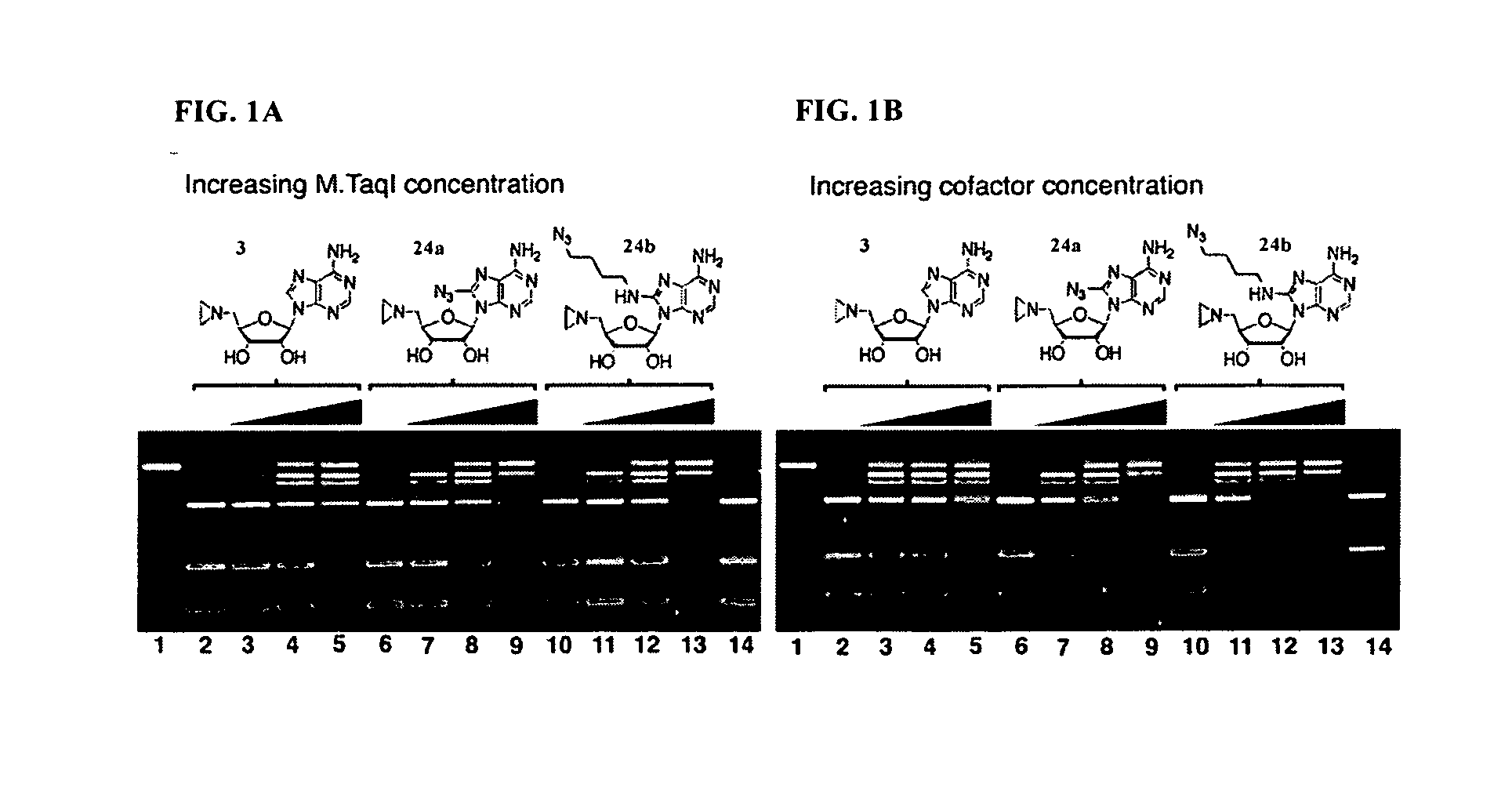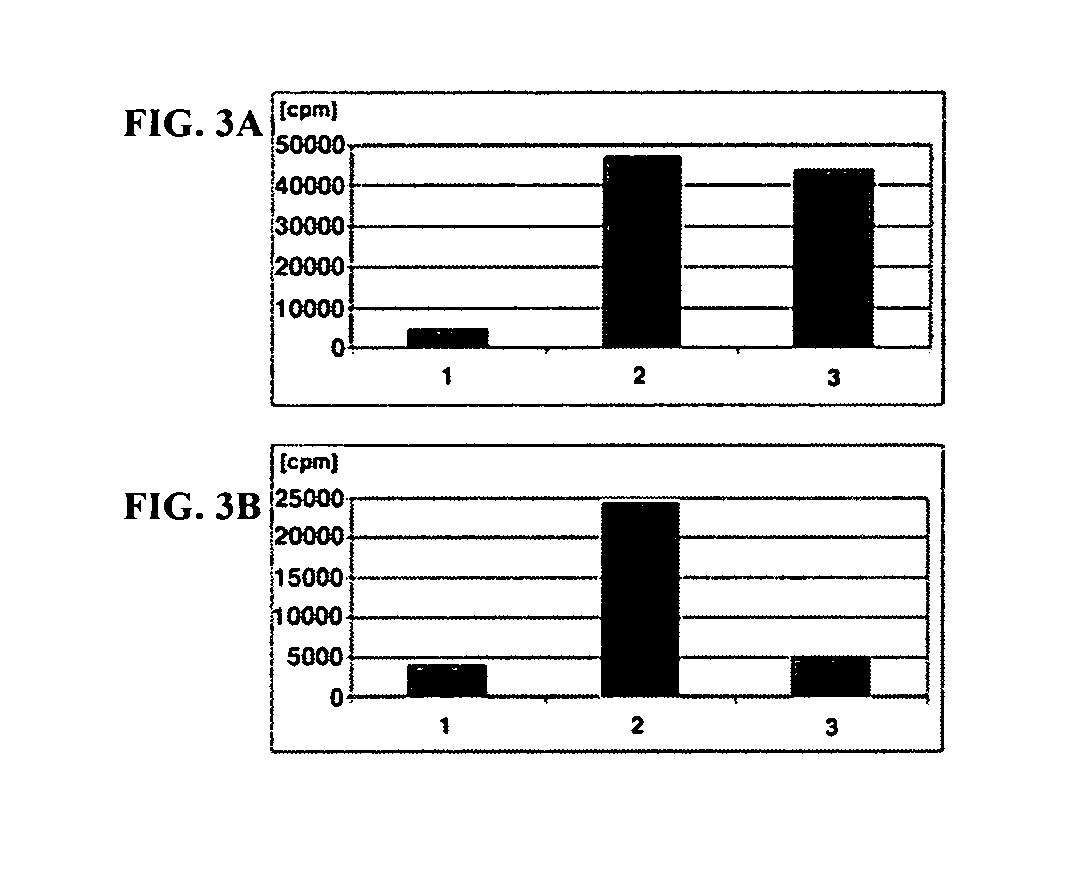Synthetic cofactor analogs of S-adenosylmethionine as ligatable probes of biological methylation and methods for their use
a technology of s-adenosylmethionine and biological methylation, which is applied in the field of analogs of sadenosyllmethionine and ligatable probes, can solve the problems of insufficient understanding of the mechanism behind this effect, lack of functional properties, and difficulty in identifying and isolating methyl groups from complex biological mixtures, etc., and achieves rapid identification.
- Summary
- Abstract
- Description
- Claims
- Application Information
AI Technical Summary
Benefits of technology
Problems solved by technology
Method used
Image
Examples
example 1
Synthesis of 5′-Azido-5′-deoxy-2′,3′-Isopropylidene Adenosine 7
[0090] To 450 mL dry THF at 0° C. was added PPh3 (21.5 g, 82.0 mmol). The solution was allowed to stir for ten min. and DEAD (14.2 g, 81.3 mmol) was added and the resulting mixture stirred for an additional ten min. The ice bath was removed and to the warming solution was added DPPA (22.6 g, 82.1 mmol) over a period of five min., followed by addition of 2′,3′-isopropylidene-adenosine 6 (commercially available from Pharma Waldhof GmbH, Dusseldorf, GDR) (25.0 g, 81.5 mmol). The reaction was allowed to stir for 36 h sheltered from light. The resulting white precipitate was filtered and washed with petroleum ether. The solvent was evaporated in vacuo to reveal a thick orange oil. Column chromatography on silica gel (3:1:0.1 EtOAc / CH2Cl2 / MeOH) afforded 7 as a gummy white solid (19.8 g, 73.1%). Mp 126-130° C. 1H NMR (CDCl3) δ 8.40 (s, 1H), 7.95 (s, 1H), 6.12 (d, J=2.4 Hz, 1H), 5.62 (bs, 2H), 5.45 (dd, J=6.4, 2.4 Hz, 1H), 5.05...
example 2
5′-Azido-5′-deoxy-2′,3′-bis-(O-triethylsilyl)adenosine 8
[0091] To 100 mL 10:1 TFA / H2O at 0° C. was added 7 (15.3 g, 45.9 mmol). After 5 min., the reaction was allowed to warm to room temperature and stirred for an additional 20 min. The solution was evaporated in vacuo and co-evaporated repetitively with ethanol to render a gummy white foam. To the crude 5′-azidoadenylate (20.7 g, 70.8 mmol) in 100 mL dry dimethylformamide (DMF) at 0° C., was added imidazole (38.6 g, 566.8 mmol) and chlorotriethylsilane (19.8 g, 131.1 mol). The reaction was stirred for 2 h at room temperature. An aqueous workup was performed (NH4Cl, EtOAc, brine), the combined organic layers dried over Na2SO4 and evaporated in vacuo. A crude light yellow solid, 8, was obtained which was taken directly forward.
example 3
5′-Amino-5′-deoxy-2′,3′-bis-(O-triethylsilyl)adenosine 9
[0092] To crude 8 (25.0 g, 48.0 mmol) in 300 mL dry THF, was added triphenylphosphine (18.9 g, 72.0 mmol) and the solution was stirred for 15 min. Water (11.2 g, 624 mmol) was added and the solution was heated at reflux for 1.5 h. The solvent was removed in vacuo. Column chromatography on silica pre-treated with 1% TEA (4:2:1 EtOAc / CH2Cl2 / MeOH) gave 9 as white solid (16.8 g, 74.0%). Mp 164-167° C. 1H NMR (CDCl3) δ 8.35 (s, 1H), 7.95 (s, 1H), 6.48 (bs, 2H), 5.86 (d, J=6.1 Hz, 1H), 5.15 (dd, J=5.9, 4.6 Hz, 1H), 4.28 (dd, J=4.4, 2.8 Hz, 1H), 4.09 (m, 1H), 3.08 (dd, J=13.5, 3.6 Hz, 1H), 3.02 (dd, J=13.3, 5.6 Hz, 1H), 2.25 (bs, 2H), 0.95 (t, J=8.0 Hz, 9H), 0.78 (t, J=8.1 Hz, 9H), 0.64 (q, J=8.0 Hz, 6H), 0.38 (qq, J=16.0, 8.0 Hz, 6H); 13C NMR (CDCl3) δ 156.2, 153.6, 150.1, 141.1, 121.0, 90.0, 87.6, 74.0, 73.8, 44.0, 7.2, 6.9, 5.8, 5.5. FAB-LRMS: calculated for C22H42N6O3Si2 (M+H+) 495.78, observed 495.2.
PUM
| Property | Measurement | Unit |
|---|---|---|
| volume | aaaaa | aaaaa |
| pH | aaaaa | aaaaa |
| pH | aaaaa | aaaaa |
Abstract
Description
Claims
Application Information
 Login to View More
Login to View More - R&D
- Intellectual Property
- Life Sciences
- Materials
- Tech Scout
- Unparalleled Data Quality
- Higher Quality Content
- 60% Fewer Hallucinations
Browse by: Latest US Patents, China's latest patents, Technical Efficacy Thesaurus, Application Domain, Technology Topic, Popular Technical Reports.
© 2025 PatSnap. All rights reserved.Legal|Privacy policy|Modern Slavery Act Transparency Statement|Sitemap|About US| Contact US: help@patsnap.com



